C&S Narrow Gauge Employee Timetables
Posted by Jim Courtney on Nov 21, 2024; 5:58am
URL: http://c-sng-discussion-forum.254.s1.nabble.com/C-S-Narrow-Gauge-Employee-Timetables-tp20302.html
A few days ago I received an unexpected gift from a gentleman named Phil Marceau. Last summer, Dale Kreutzer and I helped Phil assess/price his large Sn3 brass collection for sale. His collection included quite a few OMI Sn3 C&S locomotives, passenger cars and cabooses (that's where I came in). As a gesture of thanks, Phil sent me a couple of C&S books from his collection, a huge binder of 8x10 photos of C&S locomotives and rolling stock, and a copy of a C&S Employee Timetable for the South Park Division from the fall of 1902.
I love employee timetables as they are chock full of fascinating tidbits of info, such as: What scheduled trains ran in 1902 and when? What stations were open depots with agent/operators. Where exactly were the water tanks located? Was there a wye at Hancock in 1902? What special operational rules were in effect?
Evidently my newly acquired copy of the 1902 timetable was reprinted by the Colorado Rail Museum some 50 years ago in 1973. I completely missed it, didn't know it existed. In 1973, I was graduating from college and beginning medical school. It would be another 10 years before I developed a specific interest in the C&S narrow gauge lines, much less have time to begin modeling equipment.
The timetable is slightly larger than the scanning bed on my printer, so I had to piece together some pages vertically. I had considered sending the .jpeg files to either Darel or Mike to be placed in the files section, but it seems that few folks go there anymore. So consider this an open thread for any and all C&S narrow gauge employees timetables. So, here we go!
Page 1
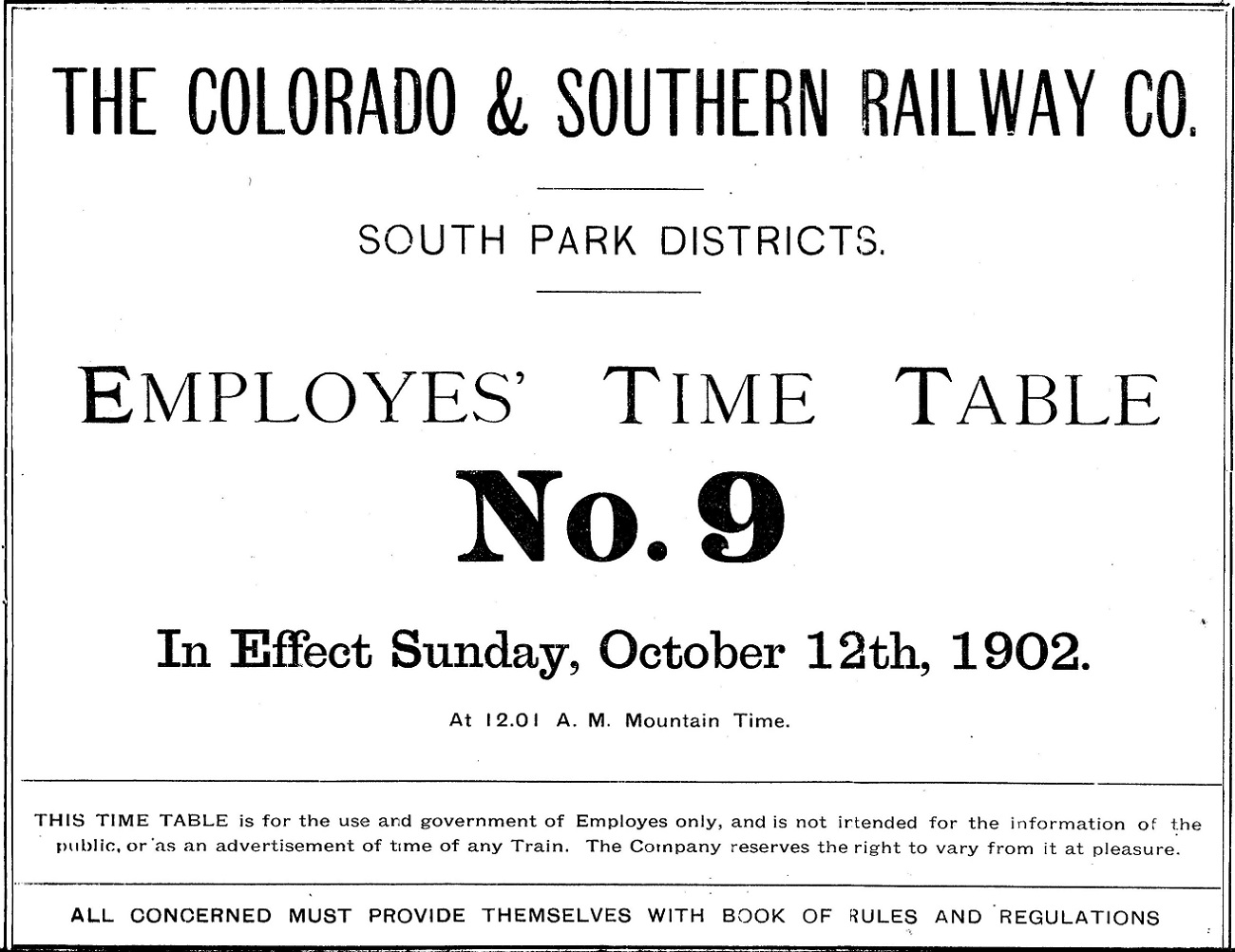
Page 2
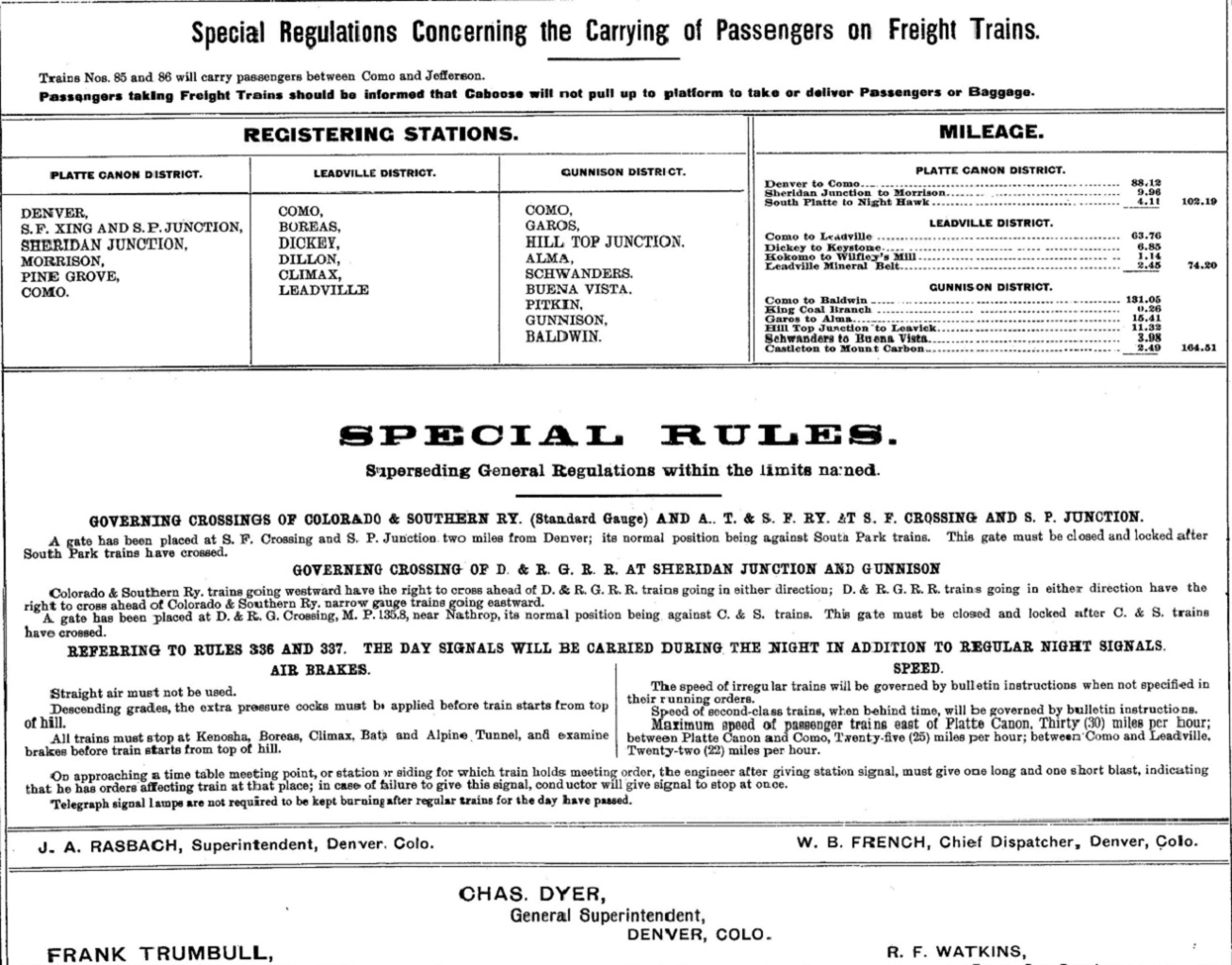
Note that in 1902, passengers could ride in the caboose of scheduled freight trains between Como and Jefferson. However, the caboose would not be spotted at the platforms, the passengers had to "lug" their luggage through the snow or weeds down the track to the depot.
In 1902, retainer valves were termed "extra pressure cocks". Straight air was not to be used in trains.
Page 3

C&S locomotive 7 was rebuilt to match its modern sisters in July, 1902. On the timetable it is still listed as a class "A" locomotive with the same low tractive effort of the never-rebuilt Cooke 2-6-0s 11, 12 and 13. Rebuilt Brooks moguls 21 and 22 have the same TE as the Cooke 2-8-0s. This is the first that I've read of locomotive classes A through D as to tractive effort. The familiar class designations (B3-C, B4-D, etc.) weren't devised until about 1906.
The chart of empty tare weights by car type is interesting . . . the big St. Charles reefers of 1900 are 5 tons heavier in light weight than the Tiffanies, and an empty flat car weighed the same as a 4-wheel bobber caboose (less crew).
The C&S narrow gauge had an extensive number of physicians/surgeons on retainer along the route--the predecessor of todays HMOs??
Both Breckenridge and Leadville had telephone service in 1902.
Page 4
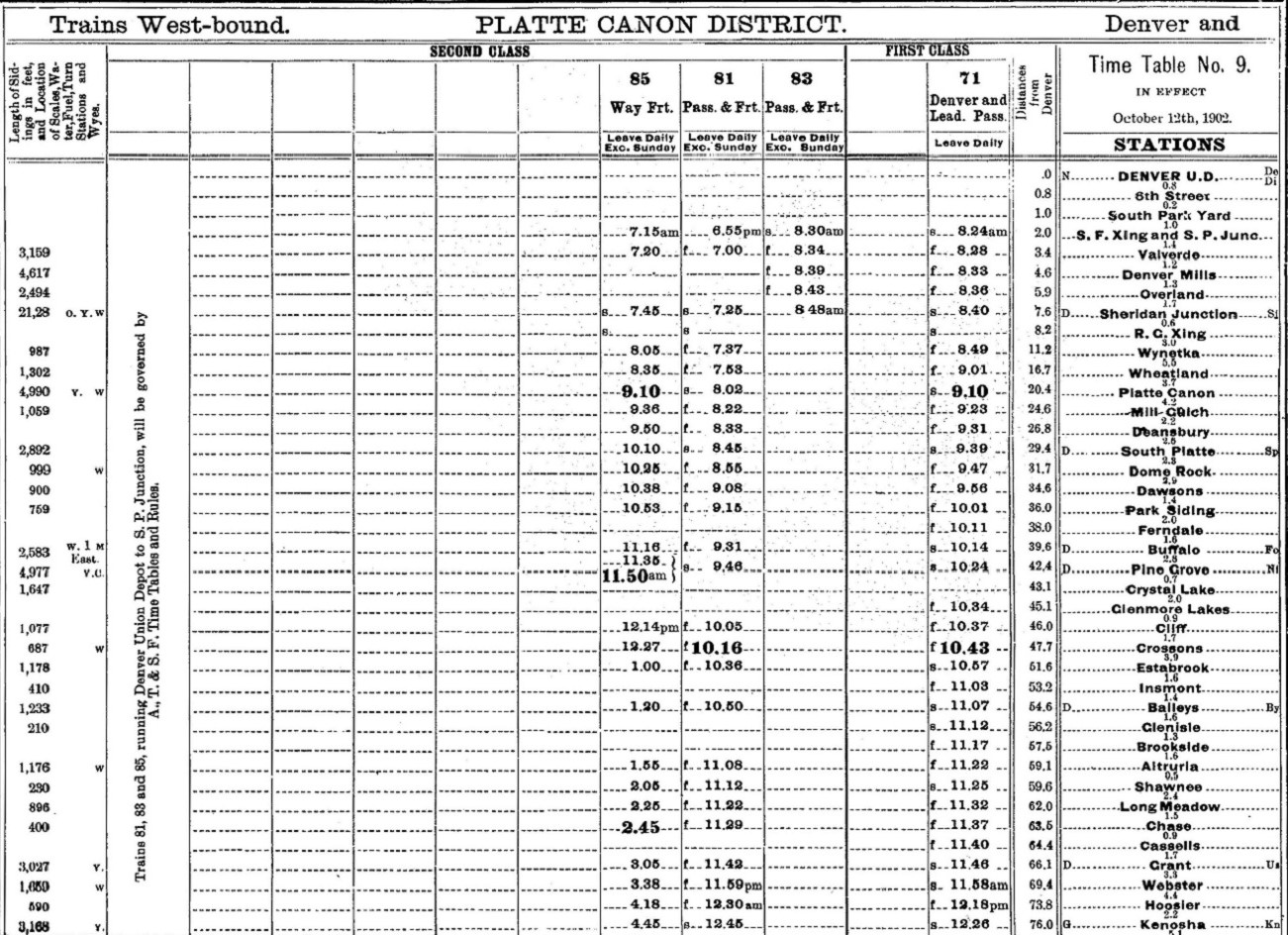

There was only one First Class train on the Platte Canon segment, the Denver-Leadville passengers, then numbered 71 westbound and 72 eastbound. As always, they met at Como.
Mixed trains 83 and 84 were the Morrison mixed trains, leaving the mainline at Sheridan Jct. The way freights numbers 85 and 86 were Second Class trains, having superiority to all extra freights that they might meet (they "kept the main" unless otherwise instructed by the dispatcher).
Mixed trains 81 and 82 were the overnight mixed trains serving Denver/Leadville. They were nicknamed the "Tomcats" (they were out all night, came in in the morning).
On the station list, the "D" denotes an open depot, with agent/telegraph operator for train orders. As no hours are listed, they were likely staffed 24/7. The telegraph call signs for the open depots are list to the right of the station name (i.e. Grant = US). Note that all the Platte Canon stations that catered to the summer tourists, do not have open depots in October, after the tourist season. Similarly no "Fish Trains" are on the timetable after Labor Day.
Page 5
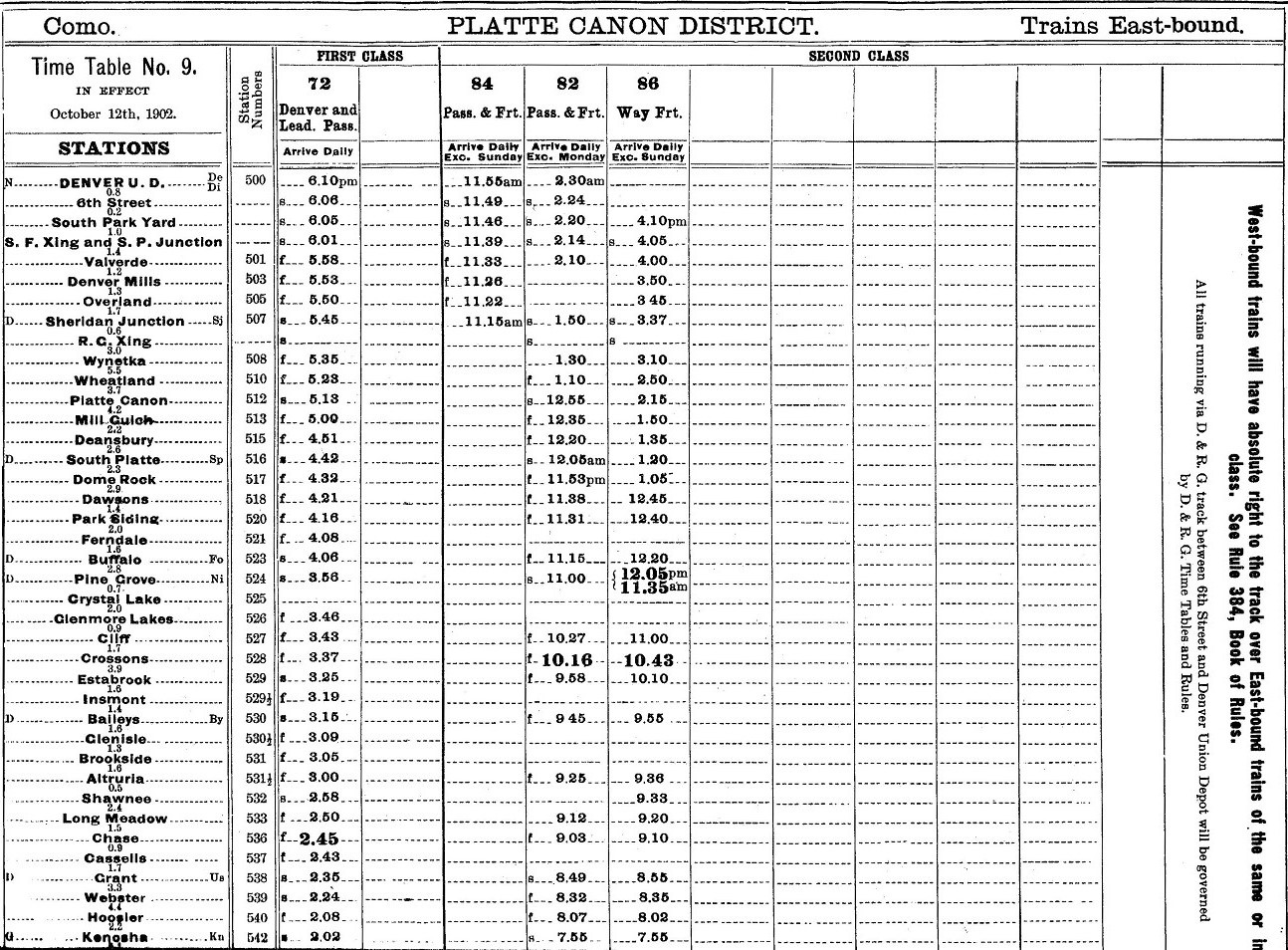

Page 6
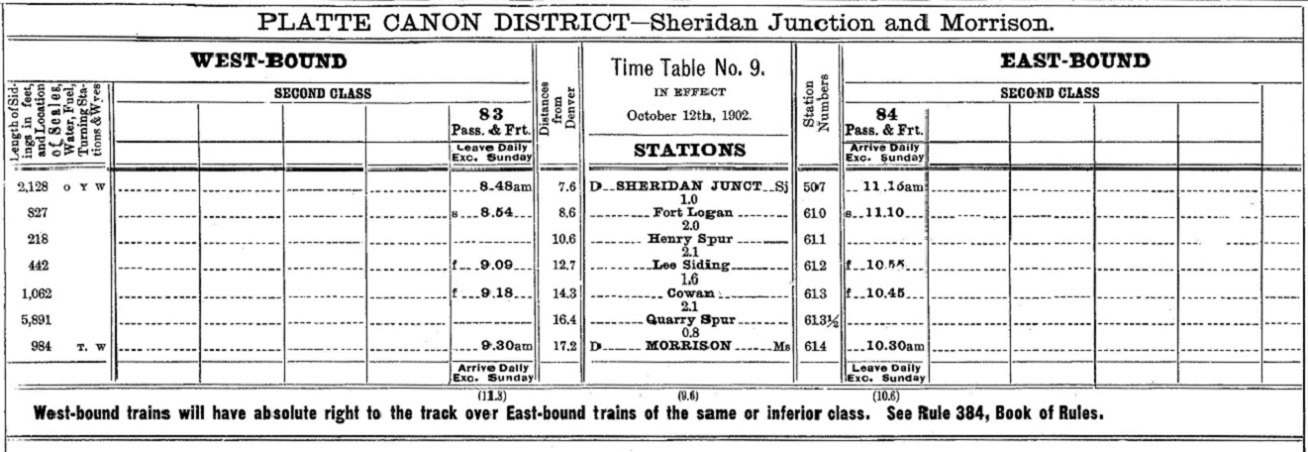
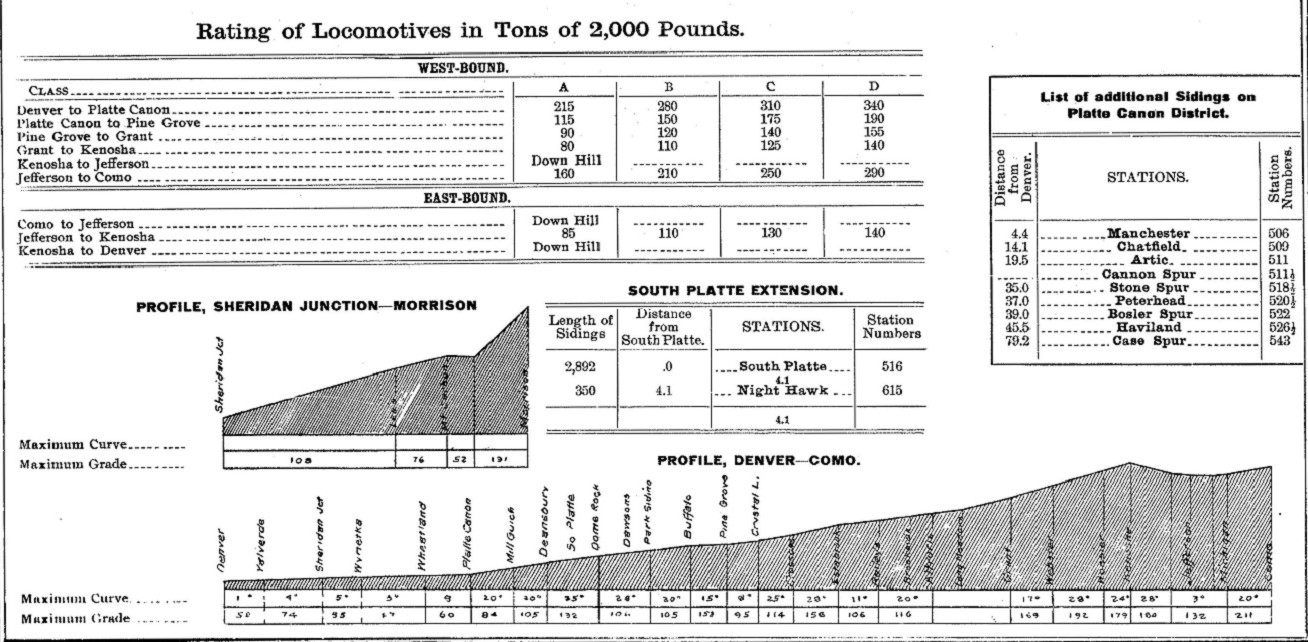
Locomotive ratings in tons are shown for the west bound grades as well as the Jefferson to Kenosha grade.
Page 7
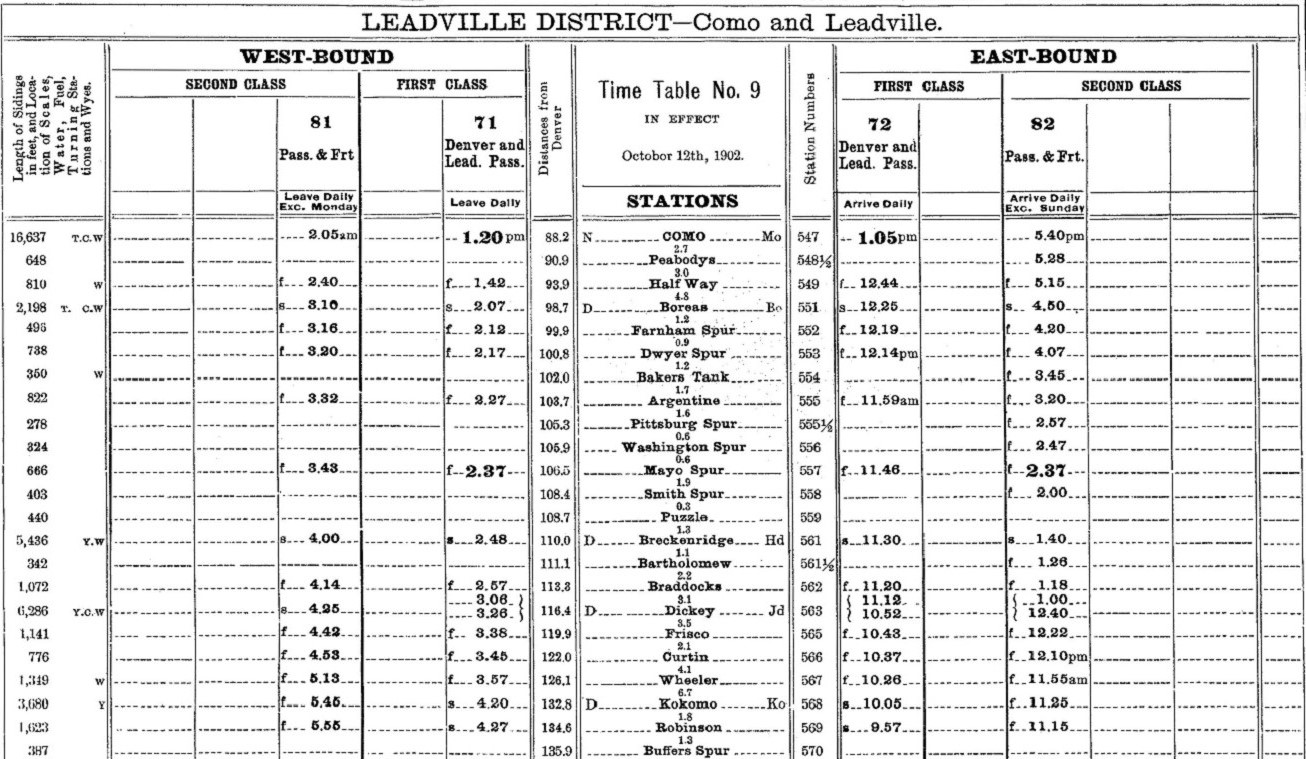

No scheduled freight trains over Boreas and up the Tenmile, just the daily passenger trains 71/72 and the Tomcats 81/82. Note that both the east bound and west bound passenger trains had a 20 minute layover at Dickey, presumably to water and coal the locomotives.
Note that the original DSP&P water tank is listed just downgrade from Kokomo in 1902. Rick Steel's B&B book says the tank burned in 1902, perhaps too late to stop the printing for a correction.
Page 8
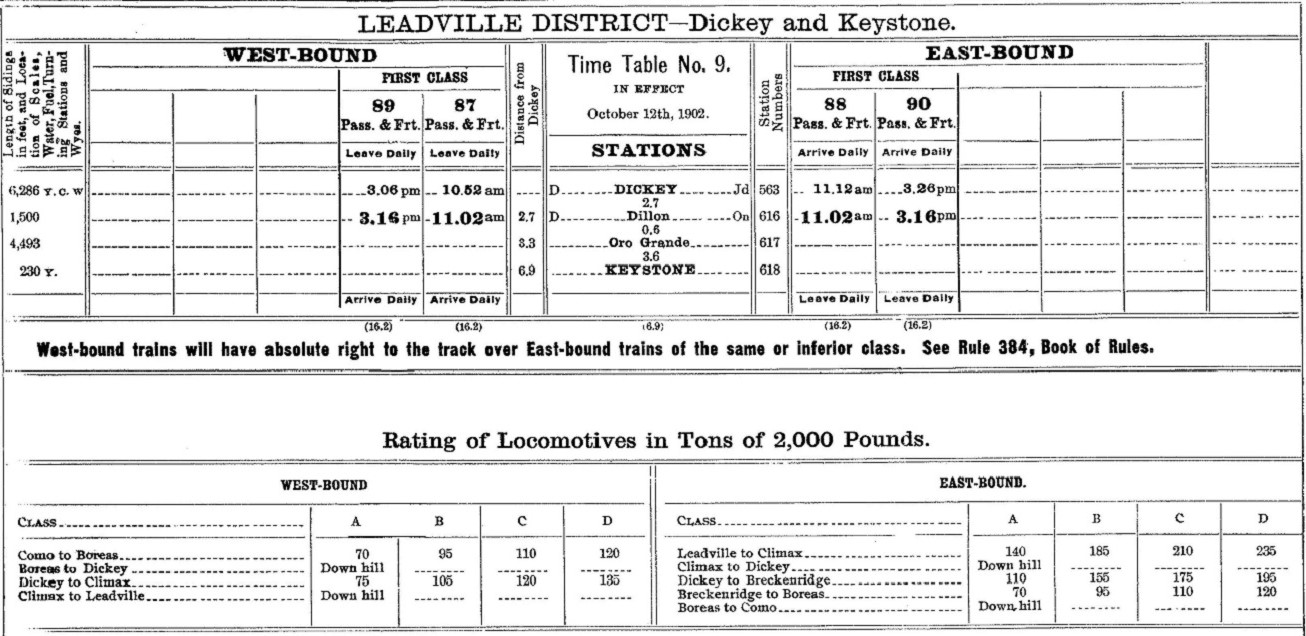
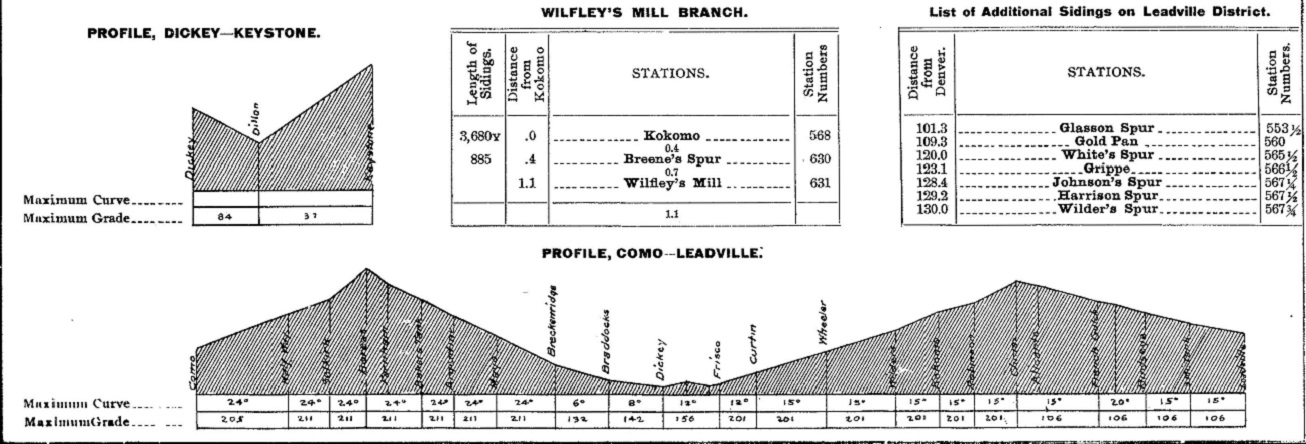
Note mixed trains 87-88 and 89-90. Both run from Dickey to Dillon and return. There is no passenger service beyond Dillon to serve Keystone and the Montezuma Mining District. Is this a separate consist (locomotive and combine) operating out of Dickey? Or, as in later years, did the two passenger trains back to Dillon and return to Dickey in that 20 minute "layover" on the prior page? If so, they would have cut in any Dillon consigned freight cars at Dickey to be considered mixed trains.
Page 9
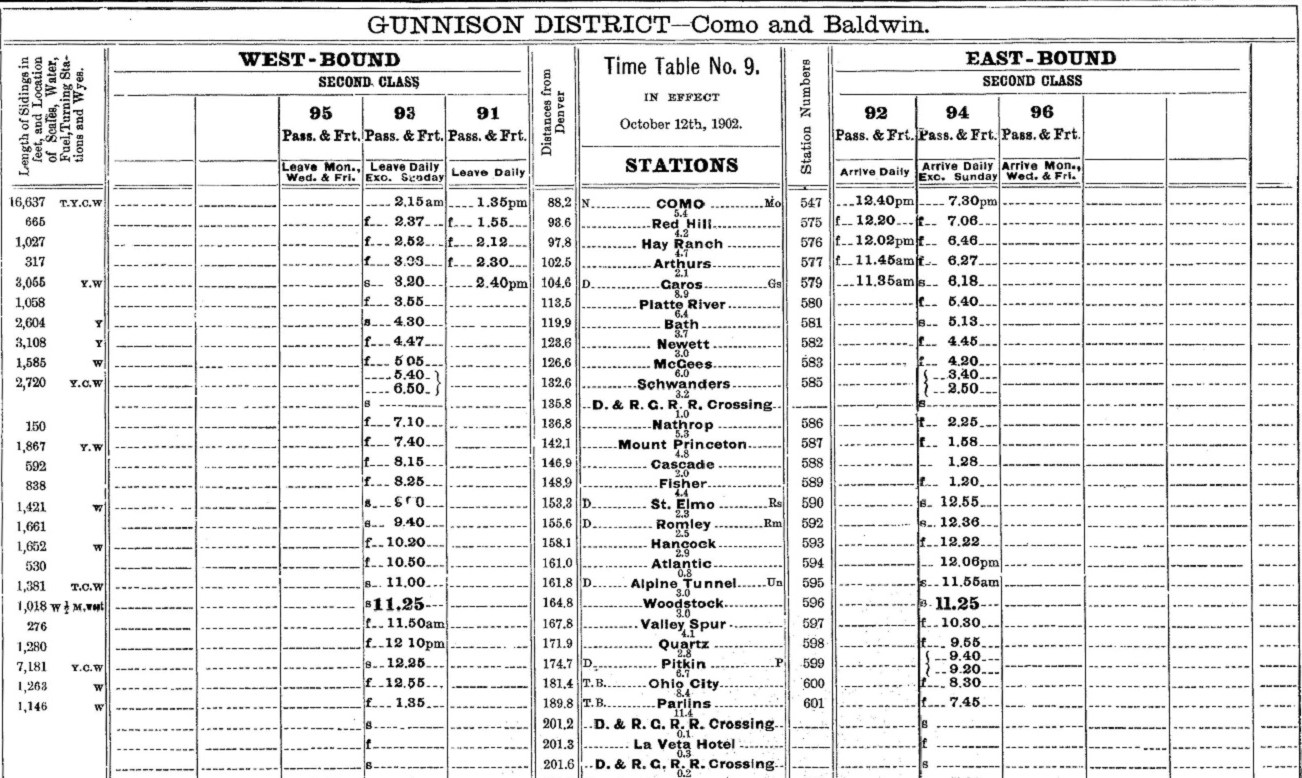

Trains 91 and 92 are the Alma mixed, joining the mainline at Garos. There was a single scheduled Second Class mixed train over Alpine Pass, 93 and 94, plus who knows how many extra freights.
On the westward climb up Chalk Creek there were only two open depots, located just a couple of miles apart: St Elmo, with an agent to handle that community's passenger and freight business, and Romley with an agent to handle the freight business of the Mary Murphy operations. No turntable is listed at St. Elmo.
Note that Hancock has a water tank listed, but no wye. This agrees with Dave Eggleston's research, that the wye at Hancock (to turn helpers) was not installed until 1903.
The stone engine house at Alpine would not burn for several more years. Both water and coal are listed at Alpine--where would they be if not inside the engine house?? A turntable is also listed as well. There is speculation that the turntable in the engine house was never in use or removed after the tunnel was reopened by Receiver Trumbull. If it wasn't available for use in 1902, why is it listed as such??
Page 10
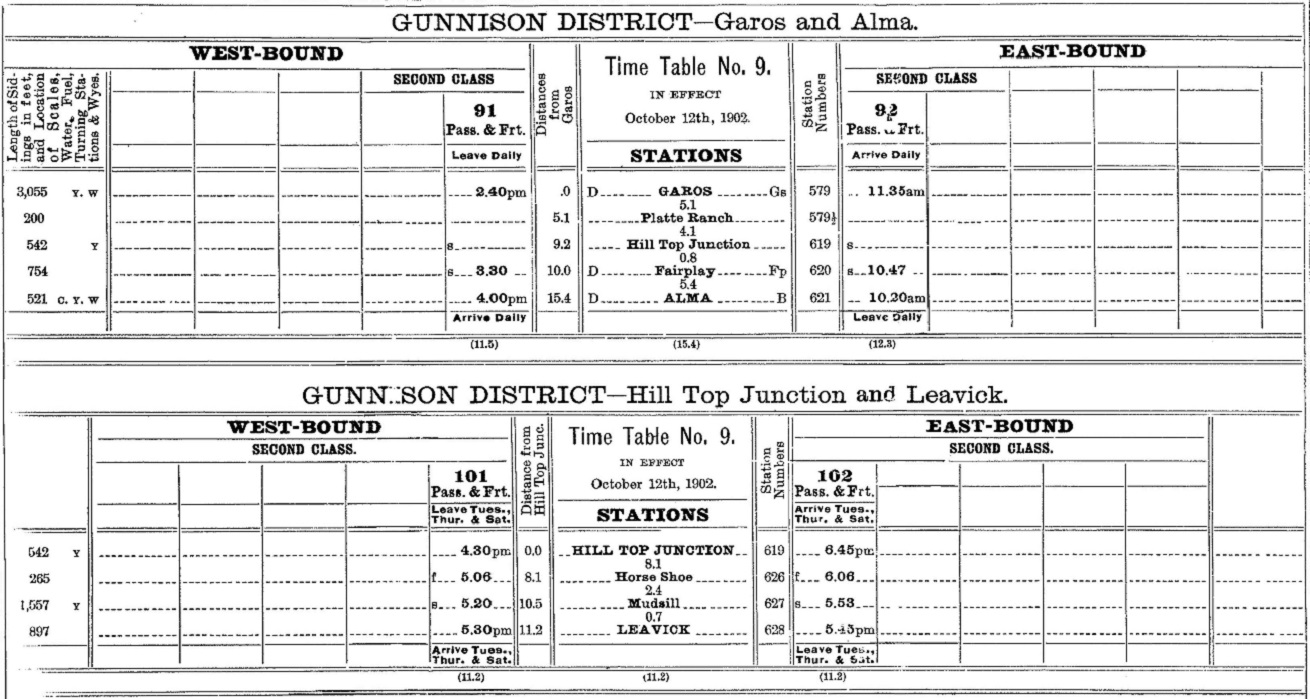

The Alma mixed left at 10:20 AM and returned from Como, arriving at 4:00 PM.
Note the operation of the Leavick Branch: Mixed trains three days a week. The train departed Hill Top Jct. at 4:30 PM, arrived Leavick an hour later at 5:30 PM, returned to Hill Top Jct. by 6:45 PM. Is this a separate consist? If so, with what did it connect?? Or, did the consist of the Alma mixed, after returning to Alma at 4:00 PM, then turn and run back down to Hill Top Jct. for a run up to Leavick and back?
Also note that Jeff Ramsey's water tank doesn't exist at Horseshoe on this timetable, nor anywhere on the branch. Was the water tank erected after 1902? A wye is located at Mudsill (just below Leavick) to turn the locomotive for the return trip.
Page 11
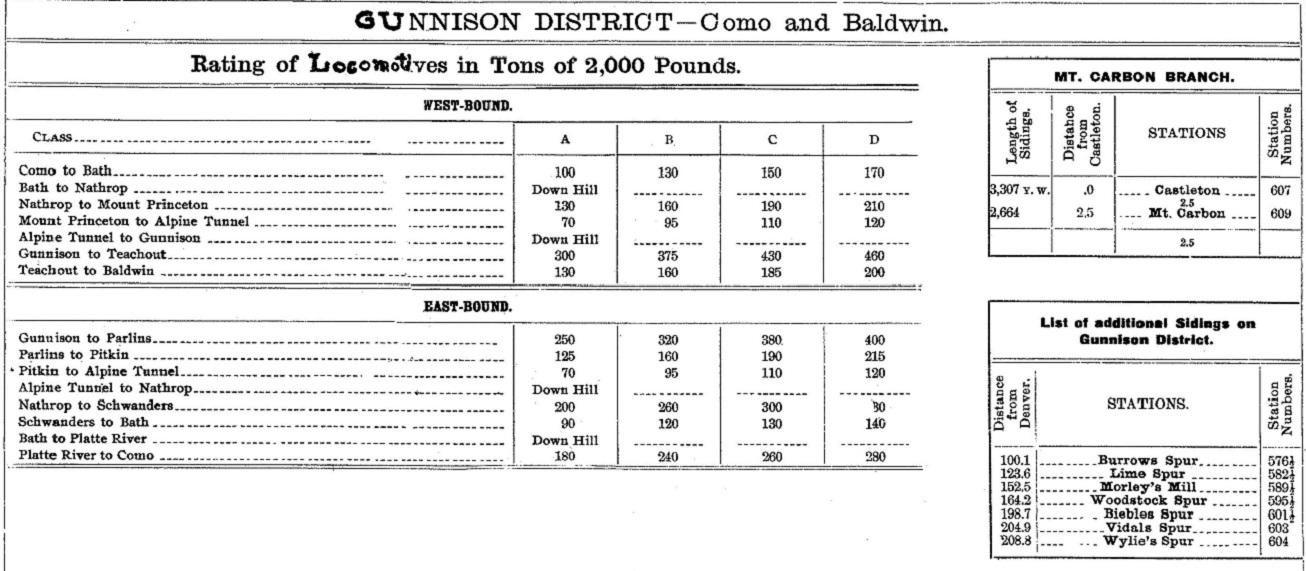
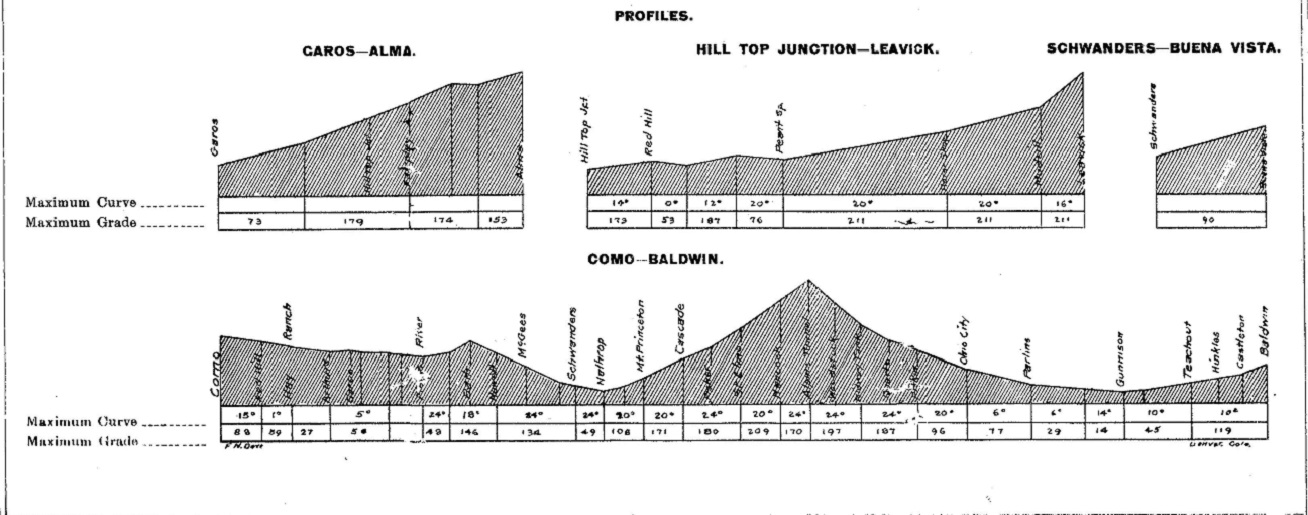
Page 12
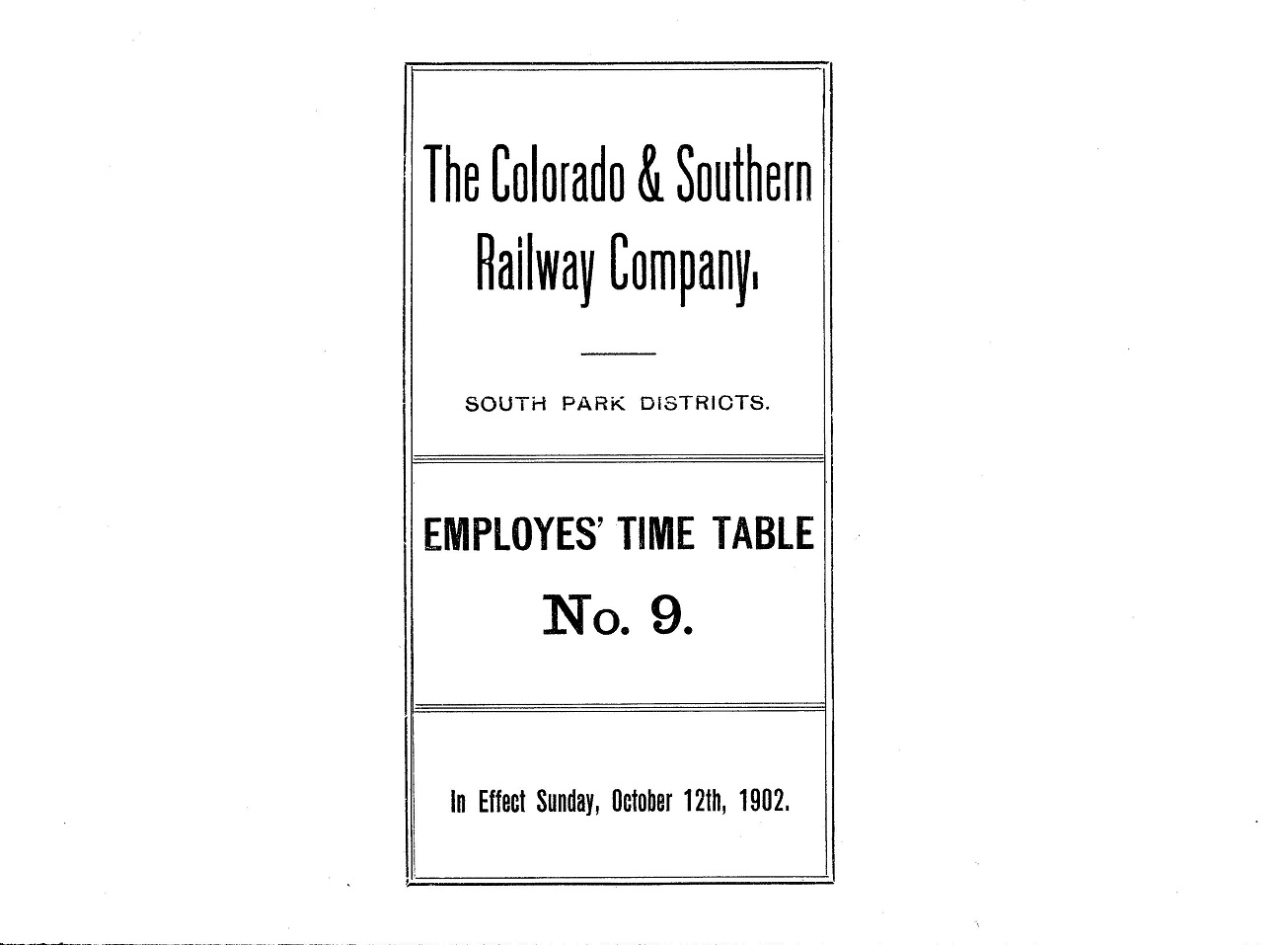
Back cover. The timetable was likely designed and printed to be folded into thirds with the center of the back page showing. This would allow it to be stored in a trainman's grip or in the inside pocket of a heavy coat for consultation. When I worked summers for the Rock Island, the CRI&P Employees Timetable measured about 4" x 8".
_______________________________________
I remember that I have a few other C&S Narrow Gauge employee timetables somewhere in my filing cabinet. When I die they will likely end up in a dumpster. As time permits, I will try to scan them and add them to this thread. If any of you have any C&S employee timetables for any of the years of C&S NG existence, please share them here.
I want to again thank Phil Marceau for sharing this wonderful document with me!
URL: http://c-sng-discussion-forum.254.s1.nabble.com/C-S-Narrow-Gauge-Employee-Timetables-tp20302.html
A few days ago I received an unexpected gift from a gentleman named Phil Marceau. Last summer, Dale Kreutzer and I helped Phil assess/price his large Sn3 brass collection for sale. His collection included quite a few OMI Sn3 C&S locomotives, passenger cars and cabooses (that's where I came in). As a gesture of thanks, Phil sent me a couple of C&S books from his collection, a huge binder of 8x10 photos of C&S locomotives and rolling stock, and a copy of a C&S Employee Timetable for the South Park Division from the fall of 1902.
I love employee timetables as they are chock full of fascinating tidbits of info, such as: What scheduled trains ran in 1902 and when? What stations were open depots with agent/operators. Where exactly were the water tanks located? Was there a wye at Hancock in 1902? What special operational rules were in effect?
Evidently my newly acquired copy of the 1902 timetable was reprinted by the Colorado Rail Museum some 50 years ago in 1973. I completely missed it, didn't know it existed. In 1973, I was graduating from college and beginning medical school. It would be another 10 years before I developed a specific interest in the C&S narrow gauge lines, much less have time to begin modeling equipment.
The timetable is slightly larger than the scanning bed on my printer, so I had to piece together some pages vertically. I had considered sending the .jpeg files to either Darel or Mike to be placed in the files section, but it seems that few folks go there anymore. So consider this an open thread for any and all C&S narrow gauge employees timetables. So, here we go!
Page 1

Page 2

Note that in 1902, passengers could ride in the caboose of scheduled freight trains between Como and Jefferson. However, the caboose would not be spotted at the platforms, the passengers had to "lug" their luggage through the snow or weeds down the track to the depot.
In 1902, retainer valves were termed "extra pressure cocks". Straight air was not to be used in trains.
Page 3

C&S locomotive 7 was rebuilt to match its modern sisters in July, 1902. On the timetable it is still listed as a class "A" locomotive with the same low tractive effort of the never-rebuilt Cooke 2-6-0s 11, 12 and 13. Rebuilt Brooks moguls 21 and 22 have the same TE as the Cooke 2-8-0s. This is the first that I've read of locomotive classes A through D as to tractive effort. The familiar class designations (B3-C, B4-D, etc.) weren't devised until about 1906.
The chart of empty tare weights by car type is interesting . . . the big St. Charles reefers of 1900 are 5 tons heavier in light weight than the Tiffanies, and an empty flat car weighed the same as a 4-wheel bobber caboose (less crew).
The C&S narrow gauge had an extensive number of physicians/surgeons on retainer along the route--the predecessor of todays HMOs??
Both Breckenridge and Leadville had telephone service in 1902.
Page 4


There was only one First Class train on the Platte Canon segment, the Denver-Leadville passengers, then numbered 71 westbound and 72 eastbound. As always, they met at Como.
Mixed trains 83 and 84 were the Morrison mixed trains, leaving the mainline at Sheridan Jct. The way freights numbers 85 and 86 were Second Class trains, having superiority to all extra freights that they might meet (they "kept the main" unless otherwise instructed by the dispatcher).
Mixed trains 81 and 82 were the overnight mixed trains serving Denver/Leadville. They were nicknamed the "Tomcats" (they were out all night, came in in the morning).
On the station list, the "D" denotes an open depot, with agent/telegraph operator for train orders. As no hours are listed, they were likely staffed 24/7. The telegraph call signs for the open depots are list to the right of the station name (i.e. Grant = US). Note that all the Platte Canon stations that catered to the summer tourists, do not have open depots in October, after the tourist season. Similarly no "Fish Trains" are on the timetable after Labor Day.
Page 5


Page 6


Locomotive ratings in tons are shown for the west bound grades as well as the Jefferson to Kenosha grade.
Page 7


No scheduled freight trains over Boreas and up the Tenmile, just the daily passenger trains 71/72 and the Tomcats 81/82. Note that both the east bound and west bound passenger trains had a 20 minute layover at Dickey, presumably to water and coal the locomotives.
Note that the original DSP&P water tank is listed just downgrade from Kokomo in 1902. Rick Steel's B&B book says the tank burned in 1902, perhaps too late to stop the printing for a correction.
Page 8


Note mixed trains 87-88 and 89-90. Both run from Dickey to Dillon and return. There is no passenger service beyond Dillon to serve Keystone and the Montezuma Mining District. Is this a separate consist (locomotive and combine) operating out of Dickey? Or, as in later years, did the two passenger trains back to Dillon and return to Dickey in that 20 minute "layover" on the prior page? If so, they would have cut in any Dillon consigned freight cars at Dickey to be considered mixed trains.
Page 9


Trains 91 and 92 are the Alma mixed, joining the mainline at Garos. There was a single scheduled Second Class mixed train over Alpine Pass, 93 and 94, plus who knows how many extra freights.
On the westward climb up Chalk Creek there were only two open depots, located just a couple of miles apart: St Elmo, with an agent to handle that community's passenger and freight business, and Romley with an agent to handle the freight business of the Mary Murphy operations. No turntable is listed at St. Elmo.
Note that Hancock has a water tank listed, but no wye. This agrees with Dave Eggleston's research, that the wye at Hancock (to turn helpers) was not installed until 1903.
The stone engine house at Alpine would not burn for several more years. Both water and coal are listed at Alpine--where would they be if not inside the engine house?? A turntable is also listed as well. There is speculation that the turntable in the engine house was never in use or removed after the tunnel was reopened by Receiver Trumbull. If it wasn't available for use in 1902, why is it listed as such??
Page 10


The Alma mixed left at 10:20 AM and returned from Como, arriving at 4:00 PM.
Note the operation of the Leavick Branch: Mixed trains three days a week. The train departed Hill Top Jct. at 4:30 PM, arrived Leavick an hour later at 5:30 PM, returned to Hill Top Jct. by 6:45 PM. Is this a separate consist? If so, with what did it connect?? Or, did the consist of the Alma mixed, after returning to Alma at 4:00 PM, then turn and run back down to Hill Top Jct. for a run up to Leavick and back?
Also note that Jeff Ramsey's water tank doesn't exist at Horseshoe on this timetable, nor anywhere on the branch. Was the water tank erected after 1902? A wye is located at Mudsill (just below Leavick) to turn the locomotive for the return trip.
Page 11


Page 12

Back cover. The timetable was likely designed and printed to be folded into thirds with the center of the back page showing. This would allow it to be stored in a trainman's grip or in the inside pocket of a heavy coat for consultation. When I worked summers for the Rock Island, the CRI&P Employees Timetable measured about 4" x 8".
_______________________________________
I remember that I have a few other C&S Narrow Gauge employee timetables somewhere in my filing cabinet. When I die they will likely end up in a dumpster. As time permits, I will try to scan them and add them to this thread. If any of you have any C&S employee timetables for any of the years of C&S NG existence, please share them here.

I want to again thank Phil Marceau for sharing this wonderful document with me!
Jim Courtney
Poulsbo, WA
Poulsbo, WA
| Free forum by Nabble | Edit this page |